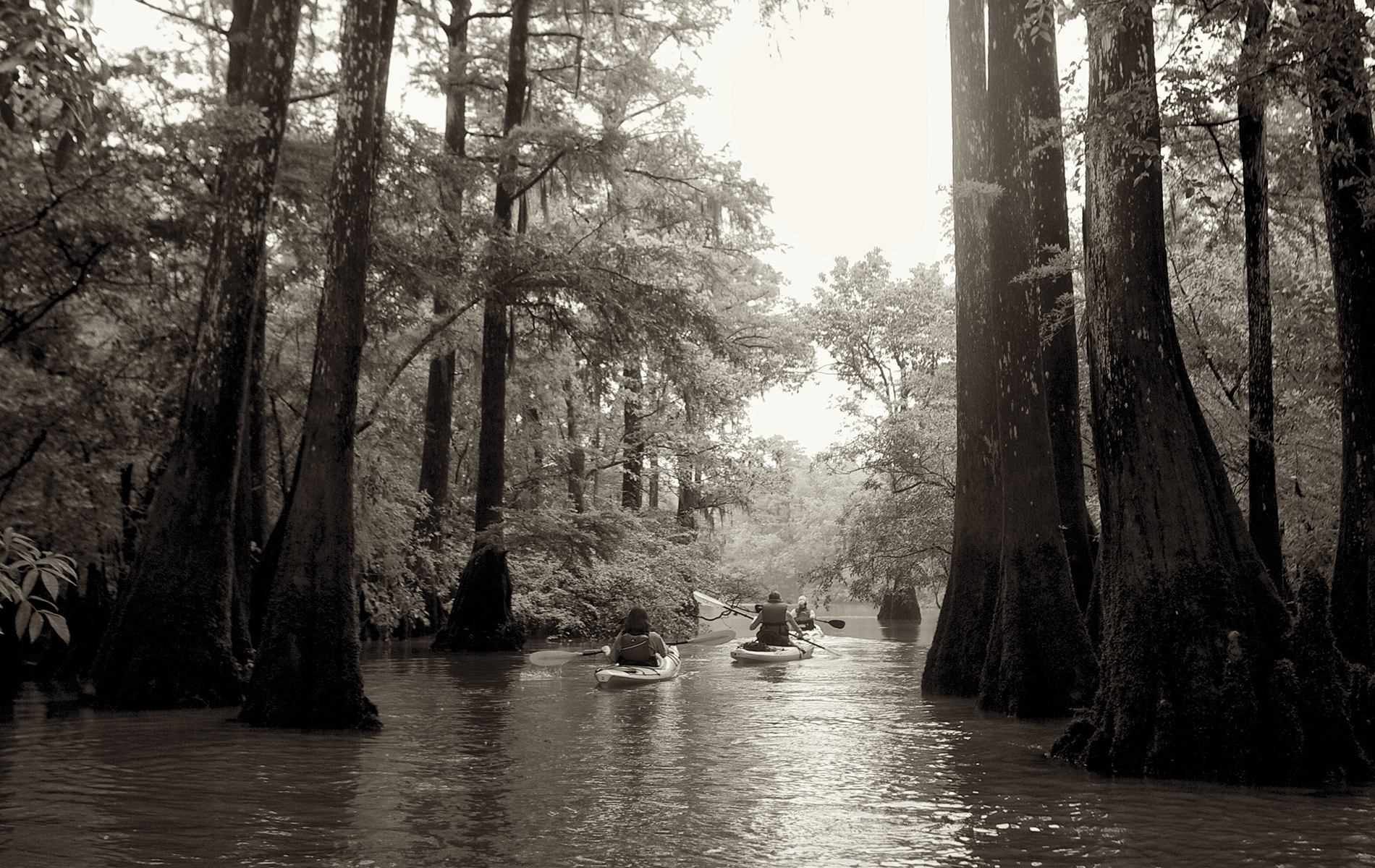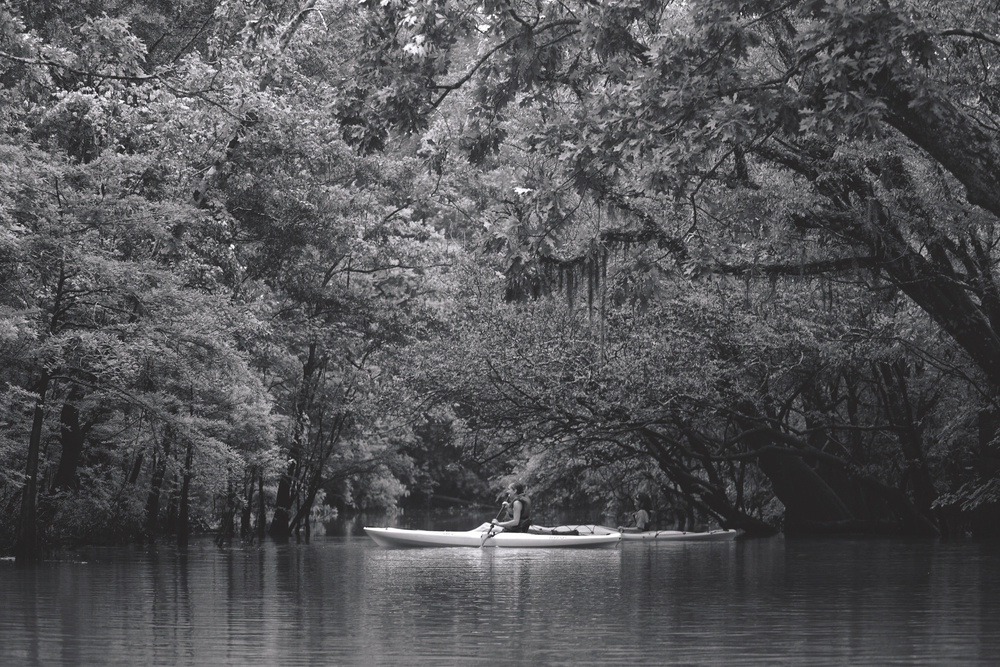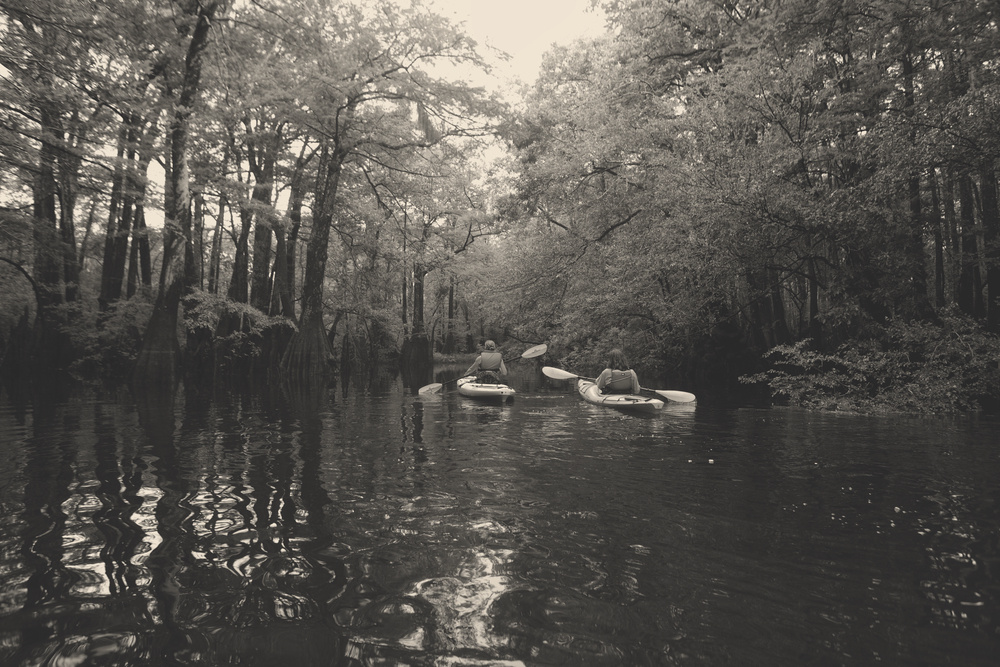
vie-magazine-paddling-through-paradise-hero
Paddling Through Paradise
Northwest Florida Ecotourism Leads the Way
By Anne Schultz | Photography By Michael Granberry
“Look! Is that an alligator!” I cry out, pointing downstream at a dark triangle trailing a black line across the water’s mirror-still surface. We watch it cruise by at a steady clip across the narrow creek to a white sandy bank studded with cypress knees.
My husband, Bill, and I are paddling the lower reaches of Seven Runs on kayaks, guided by Karl Renelt, owner of Into the Wild … Eco Diversions, and his partner, Tom Wright. The mild climate here makes ecotourism good year-round, but Karl considers the fall to spring months ideal for exploring the forests and upland waterways of Northwest Florida because cooler temperatures lower the humidity and zap the insects. The water, reflecting the morning sunlight, gleams like a satin ribbon as it winds between centuries-old cypress trees tinged autumn bronze and copper, their flared roots exposed by low water levels. The four of us are content and comfortable in yellow sit-on-top kayaks, gliding along in a reflective silence, lost in our own reverie—until I spot the moving shape.
“That’s a gator. Did you hear about the thirteen-footer brought to the Destin Rodeo last year? They pulled him out of here. That’s why Tom and I are going up ahead to be on the lookout for gators and snakes dangling from trees. You need to be careful out here. This is a really wild place.” I’d been thinking Bill and I could hitch up our kayaks to the SUV and drive up here on our own. Images of dangling snakes and alligators thirteen feet long give me second thoughts. That’s the beauty of having an experienced local guide, and one of the reasons I signed up for our first ecotourism trip in Walton County, Florida.
Bill and I are into what’s called eco- or sustainable travel. We believe that it’s the least intrusive, most intimate and respectful way to explore the wilds. It means coming in quietly in some nonmotorized way, like hiking or in a kayak, as if we were guests in someone’s home, rather than barging in loudly and obnoxiously, acting like we own the place. For twenty years, we’ve cast out in all directions for the best ecodestinations. We flew a grueling twenty-two hours to paddle icy waters at Abel Tasman National Park in New Zealand and on the same trip jumped in over our heads to kayak Milford Sound with a group of international Ironman participants in their twenties! Off the coast of Zanzibar, we stayed at Chumbe Island’s ecoresort where we hiked and snorkeled in the Indian Ocean. Now that Walton County offers a list of adventure excursions led by outfitters certified as Florida Master Naturalists, we can do the same in our own backyard without passports, jet lag, or leaving a huge carbon footprint.

Crystal clear water and stunning white sand attract millions to Northwest Florida beaches. Yet how many venture beyond a beach chair at water’s edge to discover that there is even more to this paradise? Few vacationers (or locals, for that matter) realize they are sitting on a “biological hotspot”; this region is ranked sixth in America for its biodiversity. You glimpse some of it along Highway 30-A—the scenic corridor linking South Walton County’s fifteen beach communities—while the rest is scattered in North Walton County off dusty back roads. Coastal dune lakes are rare worldwide, and yet there are fifteen of them in our area. The 15,000-acre Point Washington State Forest is home to more than ten miles of hiking trails. And an upland network of remote springs, rivers, and the Choctawhatchee Bay make this an ideal place for ecotourism to thrive.
A rich layering of forest habitats interspersed with bodies of water also attract an abundance of native birds and wildlife along with migratory ones that visit with the regularity of snowbirds driving down from Canada. The forest is home to such creatures as deer, bobcats, turkeys, and black bears. Both native and migratory birds flock to the forests, wetlands, and seashore. Monarch butterflies drift over dunes in clouds of fluttering wings as they pass by during their fall migration. Sea turtles lumber ashore in summer to lay eggs. Many species of colorful migratory birds add new songs to the area in both fall and spring. Expert guides like Karl and Tom help the average person freely enjoy these natural wonders by handling all the details. I’m also more inclined to stretch myself, explore more remote places, and take greater risks—except for swimming with that gator!—when I know a guide is handy.
That’s a gator. Did you hear about the thirteen-footer brought to the Destin Rodeo last year? They pulled
him out of here… You need to be careful out here.
This is a really wild place.
“I guarantee I’ll take you someplace you’ll see in a completely new way,” Karl says as we drive along Highway 20, a two-lane road running north and parallel to beaches. I’m skeptical. Bill and I had already driven down Highway 20 umpteen times discovering trails, hidden springs, and rivers since we moved here fifteen years ago. Off-season beach time has always meant on-season kayak and hiking time for us. The minute the winged sumac leaves turn crimson in the fall, some inner yearning makes me long for secluded forests and lonely rivers. I’m like the native black bears, foraging for food, storing up for hibernation. I want to go back into the reflective quiet of forest and stream to feast on their wild beauty and drink in their silence. So when we turn off the highway onto Dead River Road, the dirt road leading to Seven Runs, I’m amazed. How had we missed this turnoff when we had hiked the Florida Trail less than five minutes away?
I recognize another advantage of a local guide: he knows the terrain far better than we do. Karl and friend Lori Ceier, founder of www.waltonoutdoors.com, have combed the area searching for the best and most beautiful natural features around. And they’ve found a winner here. We drive through a meadow ablaze with wildflowers blooming in fiery reds, yellows, and pinks until we reach the landing and look upon Seven Runs. We gaze at the clear yet tannin-stained water, coffee color at its depths and a lighter amber tone in the shallows where we put in. There’s not another soul around.
After the alligator passes, we paddle farther downstream. Steering with our paddles, we let the swift current carry us into the haunting beauty of a cypress swamp. We stretch out, leaning back in our boats to soak up this mystical, otherworldly place where huge trees rise up from the water. Unhooked from the digital world back home, our senses are open to nature. We listen to its melodic sounds: a symphony of twittering, trilling birdsong, water lapping against the kayaks, and a woodpecker tapping in sync. This is not what I expected a swamp to look, feel, or even smell like.
People associate the odors of decay in a swamp with pollution. The smells are the by-products of untold numbers of living organisms feeding on organic
material. In reality, it’s the aroma of life.
Old Hollywood movies like Creature from the Black Lagoon have shaped our perception of swamps as foul-smelling, spooky, dank places where slimy creatures lurk. Actually, now that we are here, it feels like anything but that. This swamp feels safe and even friendly, a sanctuary of peace and beauty where massive trees tower overhead like protective guardians. Eye level to the flared trunks, we see how the elements have hewn, chiseled, and sculpted them into water-polished works of art. And the water is so clean and clear, it’s like looking through amber-colored glass at the smooth, sandy bottom. And as for the yeasty aroma, Karl explains that.
“People associate the odors of decay in a swamp with pollution. The smells are the by-products of untold numbers of living organisms feeding on organic material. In reality, it’s the aroma of life,” he said. Tom added that Native Americans depended on swamps for sustenance and then pointed out a huge trunk hollowed into a black cavity of space where they hid as sentries and kept a lookout on things. Besides the alligator we saw and the kingfisher and barred owl we heard, Tom tells us he sees ibis, green and blue herons, and a variety of woodpeckers on a regular basis. He says this area is of particular interest to people looking for the ivory-billed woodpecker, a species formerly considered extinct until sightings were verified several years ago.

No wonder ecotourism is a fast-growing segment of the travel industry. It’s good for us. The peace and serenity here quiet the mind and soothe the soul. Ecotourism takes us into pockets of paradise where nature still flourishes as God intended. There we commune with nature and reconnect with its wonder, beauty, and healing energy. And with a guide, we learn with ease. How relaxing to float down a river with the sun warming our faces, inhaling fresh organic scents, as Tom and Karl relate fascinating facts about nature laced with history and culture.
Karl made good his promise that he would take us someplace we’d “see in a completely new way.” He taught us a whole lot more about the place we’ve lived in all these years, and with this newfound knowledge and understanding, we see it as if for the first time. Whether a visitor, a newcomer to the area, or a longtime resident like myself, going on an ecoadventure guarantees that you too will see the wonderland of Walton County like you’ve never seen it before. It helps you truly understand and appreciate this incredible place where paradise encompasses the beaches and beyond.
—V—
Karl Renelt has led folks into the wilds for twenty years by kayak, hiking, biking,
or sailboat. His qualifications include Florida Master Naturalist, Walton County Nature
Based Certified Outfitter, and American Association-certified kayak instructor.
For more information, visit itwecodiversions.com
With over 40 percent of protected land available for exploration, the Walton County
Tourist Development Council promotes ecotourism using local outfitters certified as Florida
Master Naturalists by a University of Florida program. For a complete listing of
nature-based outfitters and trip descriptions, visit
visitsouthwalton.com
To learn more about Walton County nature, visit waltonoutdoors.com
Share This Story!
KEEP UP WITH THE LATEST STORIES FROM VIE
















































































































































